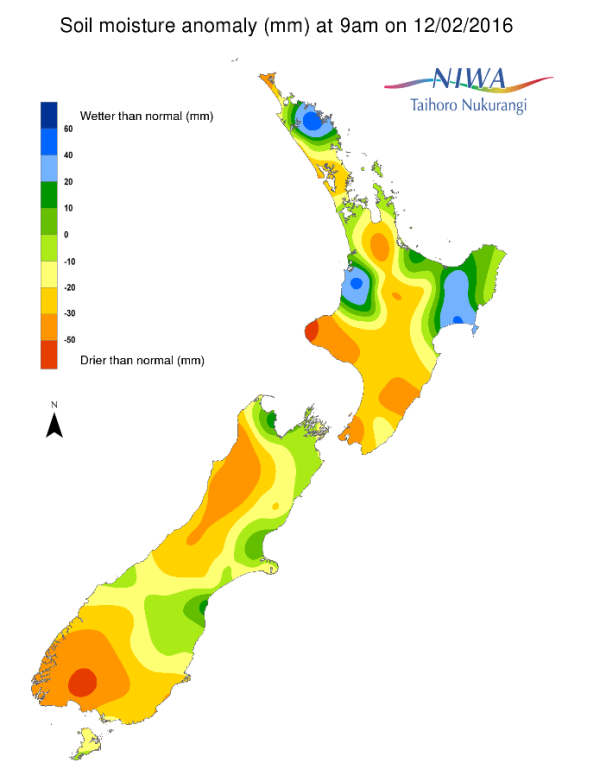A weekly update describing soil moisture across the country to help assess whether severely to extremely dry conditions are occurring or imminent. Regions experiencing these soil moisture deficits are deemed “hotspots”. Persistent hotspot regions have the potential to develop into drought.
Changes in soil moisture levels across the North Island vary when compared to this time last week, with a mixture of both increased and decreased moisture. The most significant increases were observed in west coastal Waikato, northern Taranaki, and northern Manawatu-Whanganui. Decreases were found in parts of Hawke’s Bay, coastal Gisborne and northeastern Bay of Plenty. Currently, the Coromandel Peninsula, interior Waikato and Bay of Plenty, interior Hawke’s Bay, coastal Taranaki, central and southern Manawatu-Whanganui, and Wellington-Wairarapa have below normal soil moisture for this time of the year. Soil moisture is near or above normal in eastern Northland, southwest and northern Waikato, parts of Bay of Plenty, and central and interior Taranaki and Manawatu-Whanganui.
Across the South Island, soil moisture levels have increased over the last week. The most dramatic increases were found in Fiordland, along the West Coast, and especially in Tasman, Nelson, and Marlborough. Soil moisture levels remain near or above normal in pockets of Canterbury, though drying is noticeable in interior mid-Canterbury. The most pronounced regions of below normal soil moisture on the South Island are across interior Southland and Otago.
Outlook
Following a very rainy week for some on the North Island, mostly rain-free weather is expected to return this weekend. The exception will be on Sunday when just a few, isolated showers will drop less than 5 mm across the Central Plateau. On Monday, a southerly change will bring showers to parts of Hawke’s Bay, Gisborne, the Bay of Plenty and Waikato. Falls will be generally light, with less than 5 mm in most places though up to 10 mm is possible across the higher terrain. High pressure located to the east of the North Island on Tuesday and Wednesday may allow a few light and passing showers to become embedded within the northeasterlies and affect Auckland and Northland. High pressure west of the North Island will also direct some moisture to parts of the west coast, with scattered rains affecting south coastal Waikato, Taranaki, and Manawatu-Whanganui in the mid-week. At this point, the late week looks mostly dry across the North Island, though there are a few weather features to watch. The first is long-lived Tropical Cyclone Winston, which may move southward toward New Zealand late next week. A second system may approach from the south late in the week. On the whole, the North Island looks quite dry over the next week; the driest conditions will probably extend from Gisborne to Wellington-Wairarapa.
After a very wet week for parts of the southern and western South Island, rain will continue on Saturday from Fiordland to the central West Coast. A southerly change will give the rest of Southland and Otago the opportunity for some light rain. The remainder of the South Island should have dry conditions on Saturday. Showers will persist across the far south on Sunday, with sprinkles along the east coast generated by a moist, onshore flow. High pressure will build from the south and west on Monday, giving most a dry day. A mixed flow pattern in the early-to-middle stages of next week will give the central and southern South Island the opportunity for scattered but mostly light rainfall. A more organised storm may bring a good soaking late in the week, focusing from Fiordland to the West Coast. Through the next 7 days, the lowest rainfall will most likely be found from east coastal Marlborough southward through mid-Canterbury.
Soil Moisture
For the North Island, hotspot areas have been eliminated in extreme northern and southern Northland, northern Auckland, central Waikato, and parts of Taranaki and interior Manawatu-Whanganui. Hotspot areas remain present in extreme west coastal and southern Taranaki, parts of southern Manawatu-Whanganui, parts of Hawke’s Bay, and much of Wellington-Wairarapa. New hotspots have developed over the Coromandel Peninsula and extreme east coastal Gisborne over the last week. Little in the way of organised rainfall through the next week will favour hotspot expansion across much of the North Island. New hotspot areas may develop in northern Hawke’s Bay and across the Bay of Plenty over the course of the seven days.
Hotspot areas remain present across central and eastern Southland, southern Otago, and interior central Canterbury on the South Island. A new hotspot has developed in northern Canterbury over the past week. Hotspot areas across the eastern and northern South Island may expand over the next week. Hotspot areas elsewhere may remain the same or worsen slightly as rainfall over the next 7 days focuses from Fiordland to the central West Coast.
NB: due to the timing and reporting of daily 24 hour rainfall amounts (9 am each day) and time required to compute soil moisture deficit values, the rain that occurred on Friday 19 February will not be fully reflected in the soil moisture anomaly maps until Saturday 20 February.
Background
Hotspot Watch a weekly advisory service for New Zealand media. It provides soil moisture and precipitation measurements around the country to help assess whether extremely dry conditions are imminent.
Soil moisture deficit
Soil moisture deficit is the amount of water needed to bring the soil moisture content back to field capacity, which is the maximum amount of water the soil can hold.
Soil moisture anomaly
This is the difference between the historical normal soil moisture deficit (or surplus) for a given time of year and actual soil moisture deficits.
Definitions
“Extremely” and “severely” dry soils are based on a combination of the current soil moisture status and the difference from normal soil moisture (see soil moisture maps at https://www.niwa.co.nz/climate/nz-drought-monitor/droughtindicatormaps).
Soil moisture anomaly maps
Pictured below are soil Moisture Anomaly Maps, relative to this time of year. The maps show soil moisture anomaly for the past two weeks.


